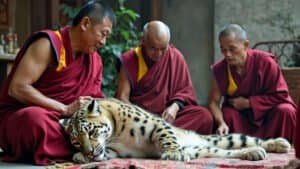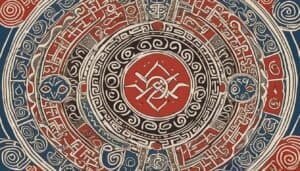Introduction
The snow leopard holds a unique place in the cultures of the indigenous peoples of the Himalayas. This elusive and majestic predator is not only a symbol of natural beauty but also a significant figure in the spiritual and cultural life of many Himalayan tribes
In this article, we will explore the deep cultural significance of snow leopards among these communities, delve into their spiritual connections, and examine the traditional conservation practices that have helped sustain the snow leopard population
We will also look into the myths and folklore that surround this iconic creature, shedding light on its role in the cultural identity of Himalayan peoples
Cultural Significance of Snow Leopards Among Himalayan Peoples
Snow leopards are deeply embedded in the cultural fabric of the indigenous peoples of the Himalayas. These elusive creatures, often referred to as the “ghosts of the mountains,” are not merely animals but carry profound cultural and symbolic meanings
Across various Himalayan tribes, snow leopards are seen as symbols of strength, resilience, and mystique, embodying the spirit of the harsh yet beautiful mountainous environment they inhabit
Historical Views and Importance
Historically, snow leopards have been revered by several indigenous groups throughout the Himalayan region. These majestic predators were often seen as protectors of the high mountain regions and were respected for their ability to survive in the rugged terrain
In many communities, the presence of snow leopards was believed to bring good fortune, and their elusive nature was admired as a sign of their special status in the natural world
For instance, in Tibetan culture, snow leopards are linked to the deity Milarepa, a revered figure in Tibetan Buddhism, who is often depicted with snow leopards
This association elevates the snow leopard to a spiritual symbol of protection and divine power, making it a creature of great importance in religious and cultural practices. Similarly, in Bhutan, the snow leopard is considered a national symbol and a guardian of the mountains, often appearing in traditional art and folklore as a creature of mystical powers
Symbolism and Meaning in Different Tribes
The symbolism of snow leopards varies among different Himalayan tribes but consistently emphasizes their connection to nature and spirituality. Among the Sherpa people of Nepal, snow leopards are often associated with the gods of the mountains
The Sherpas, who live in close proximity to the towering peaks of the Himalayas, view snow leopards as sacred animals that must be respected and protected. The killing of a snow leopard is considered a grave offense, as it is believed to anger the mountain gods, bringing misfortune to the community
In the Ladakh region of India, snow leopards are known as “Shan” and are revered in both Buddhist and animist traditions. Ladakhi Buddhists see the snow leopard as an incarnation of the mountain spirits, embodying the soul of the wilderness
In animist beliefs, the snow leopard is seen as a spirit guide, leading people through the treacherous landscapes of the Himalayas. This reverence translates into conservation practices, where traditional beliefs discourage the hunting of snow leopards, viewing such actions as disrespectful to the spirits
Impact on Daily Life and Traditions
The cultural significance of snow leopards extends beyond symbolism and spirituality, influencing the daily lives and traditions of Himalayan peoples. In many communities, the snow leopard is a central figure in festivals, rituals, and storytelling
For example, in the Hemis Festival of Ladakh, one of the most important cultural events in the region, the snow leopard is celebrated through traditional dances and performances, highlighting its importance in local folklore
Additionally, snow leopards play a role in the traditional ecological knowledge of these communities. The understanding of snow leopard behavior and its role in the ecosystem is passed down through generations, shaping how people interact with their environment
This knowledge is crucial for the sustainable management of natural resources, as it promotes a balanced relationship between humans and wildlife
Spiritual Connections Between Indigenous Peoples and Snow Leopards
The spiritual connections between the indigenous peoples of the Himalayas and snow leopards are deeply ingrained in their beliefs, rituals, and practices
These majestic animals are often seen as sacred beings, embodying the spirits of the mountains and serving as intermediaries between the human world and the divine. This spiritual bond has shaped not only how snow leopards are perceived but also how they are treated within these communities
Reverence and Worship Practices
In many Himalayan cultures, snow leopards are revered as sacred animals, and their presence is often interpreted as a sign of divine favor. Among the Tibetan Buddhists, snow leopards are associated with various deities and are believed to possess spiritual powers
For example, in Tibetan Buddhist art and iconography, snow leopards are sometimes depicted alongside Padmasambhava, also known as Guru Rinpoche, who is a key figure in Tibetan Buddhism. The snow leopard, in this context, symbolizes spiritual guardianship and protection, further elevating its status within the community
The worship of snow leopards is also evident in various rituals and ceremonies. In some regions, offerings are made to snow leopards as a way to appease the mountain spirits and ensure harmony between humans and the natural world
These rituals often involve prayers, the burning of incense, and the creation of prayer flags, all intended to honor the snow leopard and seek its blessings for the well-being of the community
Sacred Status and Spiritual Roles
The sacred status of snow leopards is not only tied to religious beliefs but also to the spiritual roles they play in the lives of Himalayan peoples. In many indigenous traditions, snow leopards are seen as spirit animals or totems, representing the qualities of strength, courage, and resilience
This belief is particularly strong among the Dolpo people of Nepal, who view the snow leopard as a protector and guide in their spiritual journeys. The Dolpo people believe that the snow leopard can traverse the physical and spiritual realms, acting as a bridge between the two
Similarly, in Bhutanese culture, the snow leopard is considered a “tiger of the snow,” a powerful spiritual being that embodies the spirit of the high mountains. The Bhutanese people often invoke the snow leopard in prayers and chants, seeking its protection and guidance
The snow leopard’s ability to navigate the treacherous mountain terrain is seen as a metaphor for spiritual ascension, symbolizing the journey towards enlightenment
Shamanistic Beliefs and Rituals
Shamanism plays a significant role in the spiritual life of many Himalayan tribes, and snow leopards feature prominently in shamanistic practices
Among the shamans of the Altai region, which borders the Himalayas, snow leopards are believed to be spirit helpers or guides that assist shamans in their rituals. These spirit animals are thought to provide shamans with the power and wisdom needed to heal the sick, communicate with the spirit world, and protect their communities from harm
In these shamanistic traditions, the snow leopard is often called upon during trance ceremonies, where the shaman enters an altered state of consciousness to connect with the spirit world
The snow leopard, as a powerful spirit guide, is believed to lead the shaman through the spiritual realms, helping them navigate the challenges and dangers they might encounter. This deep spiritual connection is reflected in the way snow leopards are treated, with great respect and care given to ensure that these sacred animals are not harmed
Traditional Conservation Practices and Snow Leopards
The indigenous peoples of the Himalayas have long practiced conservation methods that reflect their deep respect for snow leopards and the natural world. These practices are rooted in traditional beliefs and cultural values, which emphasize the importance of harmony between humans and nature
The integration of these beliefs into daily life has contributed to the preservation of snow leopards, even as external pressures threaten their survival
Indigenous Approaches to Wildlife Preservation
Indigenous approaches to wildlife preservation in the Himalayas are often based on a holistic understanding of the ecosystem, where every species, including snow leopards, has a vital role. The traditional ecological knowledge passed down through generations includes practices that promote sustainable living and the protection of wildlife habitats
For example, the Amchi medical tradition in Tibet and Nepal, which relies heavily on the use of natural resources, promotes the conservation of local flora and fauna
Amchi practitioners, who are traditional healers, have long recognized the importance of maintaining biodiversity, including the habitats of snow leopards, to ensure the availability of medicinal plants and healthy ecosystems. This understanding has led to the protection of snow leopard habitats as a crucial part of preserving the overall health of the environment
In addition, many Himalayan communities have established community-managed conservation areas, where local people actively participate in the protection of wildlife, including snow leopards
These areas are often governed by traditional laws and customs, which dictate how resources should be used and protected. For instance, in the Spiti Valley of India, the local community has established a conservation program that not only protects snow leopards but also promotes ecotourism as a sustainable alternative to traditional livelihoods, thereby reducing human-wildlife conflict
Impact of Traditional Beliefs on Conservation
Traditional beliefs play a significant role in shaping conservation practices among Himalayan indigenous peoples. The reverence for snow leopards as sacred animals often translates into protective measures that prevent their hunting and ensure the preservation of their habitats
This cultural respect is evident in the taboos and restrictions placed on hunting snow leopards, which are enforced not only by social norms but also by spiritual beliefs
In some Himalayan communities, snow leopards are believed to be the reincarnations of ancestors or deities, making it a sacrilege to harm them. This belief acts as a powerful deterrent against poaching and other activities that could endanger the species. The spiritual connection to snow leopards reinforces the idea that their protection is not just a practical concern but a moral and religious duty
Moreover, traditional festivals and rituals often include practices that promote conservation. During these events, community members come together to celebrate the snow leopard and other wildlife, reinforcing their collective responsibility to protect these animals
These celebrations serve as a reminder of the cultural and spiritual importance of snow leopards, ensuring that conservation efforts are supported by the entire community
Modern Conservation Efforts Influenced by Indigenous Practices
Modern conservation efforts in the Himalayas have increasingly recognized the value of integrating indigenous knowledge and practices
Organizations working to protect snow leopards have collaborated with local communities to develop conservation strategies that respect and incorporate traditional beliefs. This partnership has proven to be effective in creating sustainable conservation programs that are culturally appropriate and widely accepted by local people
One example is the Snow Leopard Trust, which works with local communities across the snow leopard’s range to implement conservation programs that align with traditional practices
In Mongolia and India, the trust has supported community-based conservation initiatives that involve local people in monitoring snow leopard populations and managing grazing practices to reduce human-wildlife conflict. These initiatives have been successful in increasing snow leopard numbers while also improving the livelihoods of local communities
In Nepal, the Annapurna Conservation Area Project (ACAP) is another example of how traditional practices are being integrated into modern conservation efforts
ACAP has involved local communities in the management of protected areas, where traditional beliefs about snow leopards are respected and used to guide conservation decisions. This approach has helped build trust between conservationists and local people, ensuring that snow leopard protection efforts are sustainable and effective
Snow Leopards in Himalayan Myths and Folklore
Snow leopards hold a prominent place in the myths and folklore of the Himalayan region, reflecting the deep cultural and spiritual connection that indigenous peoples have with these majestic animals
Through stories passed down over generations, snow leopards are portrayed as symbols of mystery, power, and spiritual significance. These narratives not only serve to entertain but also to educate and preserve the values and beliefs of the communities that share their mountain home with these elusive creatures
Popular Myths and Legends
One of the most enduring legends involving snow leopards is found among the Sherpa people of Nepal. According to this legend, snow leopards are the earthly manifestations of mountain deities who protect the high-altitude regions from evil spirits
These deities, known as “Lung-ta,” are believed to ride on the backs of snow leopards, using their power to safeguard the mountain passes and ensure the safety of travelers. The presence of a snow leopard is therefore considered a good omen, signifying the protection of the divine
In Bhutan, the snow leopard is often associated with the mythical creature known as the “tiger of the snow.” This mythical animal is said to possess magical abilities, including the power to move between the physical and spiritual worlds
Bhutanese folklore tells of snow leopards guiding lost travelers to safety, leading them out of treacherous mountain terrain. These stories reinforce the snow leopard’s status as a guardian of the mountains, a role that is deeply respected and honored in Bhutanese culture
Another popular myth comes from the Ladakhi people of India, who tell of a snow leopard that is both a hunter and a protector. In this tale, the snow leopard is tasked with maintaining the balance of life in the mountains, hunting the weak and sick to keep the ecosystem healthy
However, the snow leopard is also seen as a protector of the villages, keeping away harmful spirits and ensuring the prosperity of the people. This duality of the snow leopard as both a fierce predator and a benevolent guardian is a recurring theme in many Himalayan myths
Role in Folklore and Storytelling
The role of snow leopards in Himalayan folklore goes beyond mere myth; they are central figures in storytelling traditions that convey important cultural values and lessons. These stories often highlight the themes of respect for nature, the interconnectedness of all living beings, and the importance of balance in the natural world
For example, in Tibetan storytelling, the snow leopard is often depicted as a wise and noble creature that embodies the harsh yet beautiful reality of life in the mountains
Stories about snow leopards are used to teach children about the dangers and wonders of the high-altitude environment, as well as the need to respect and protect the wildlife that inhabits it. These narratives also emphasize the snow leopard’s role as a symbol of resilience, inspiring listeners to endure and overcome the challenges they may face
In Ladakh, traditional folktales often feature the snow leopard as a character who outsmarts other animals or humans, using its intelligence and cunning to survive in the harsh mountain environment
These tales serve not only as entertainment but also as moral lessons, illustrating the importance of wisdom, patience, and respect for the natural world. The snow leopard’s portrayal as a clever and resourceful animal reinforces its status as a revered and respected figure in Ladakhi culture
Influence on Cultural Identity
The influence of snow leopards on the cultural identity of Himalayan peoples is profound. These animals are more than just symbols; they are integral to the way these communities understand themselves and their relationship with the natural world
The stories, myths, and legends that feature snow leopards are a testament to the deep connection between these animals and the people who live in the shadow of the Himalayas
In many Himalayan cultures, the snow leopard is seen as a totemic animal, representing the spirit of the mountains and the resilience of the people who inhabit them. This totemic significance is reflected in the rituals, festivals, and everyday practices that honor the snow leopard and its role in the community
For example, during the annual Hemis Festival in Ladakh, the snow leopard is celebrated through dance and music, with performers donning masks and costumes that depict the animal’s grace and power. This festival not only celebrates the snow leopard but also reaffirms the cultural identity of the Ladakhi people, who see themselves as protectors of the mountain environment
The snow leopard’s influence on cultural identity is also evident in the way it is depicted in art and literature. Traditional paintings, sculptures, and carvings often feature snow leopards, symbolizing the spiritual connection between the people and the mountains
These artistic representations serve as reminders of the snow leopard’s importance in the cultural heritage of the region, preserving the legacy of these animals for future generations
Conclusion
The relationship between the indigenous peoples of the Himalayas and snow leopards is one of profound respect and deep spiritual connection. Snow leopards are not merely animals in these cultures; they are revered as sacred beings, protectors, and symbols of resilience and strength
Through centuries, they have been woven into the cultural, spiritual, and ecological fabric of Himalayan life, influencing rituals, conservation practices, and even the way communities view their place in the natural world
The cultural significance of snow leopards is evident in the myths, legends, and folklore that celebrate their mystical presence, highlighting their role as guardians of the mountains. This respect extends to traditional conservation practices that have played a crucial role in preserving snow leopard populations, ensuring that these majestic animals continue to thrive in their natural habitats
As modern conservation efforts increasingly recognize the value of indigenous knowledge, the partnership between traditional beliefs and contemporary science offers hope for the future of snow leopards
The snow leopard’s influence on Himalayan cultures is a testament to the enduring power of nature in shaping human beliefs, traditions, and identities. By understanding and honoring these connections, we can work towards a future where snow leopards and the cultures that revere them continue to coexist and flourish










